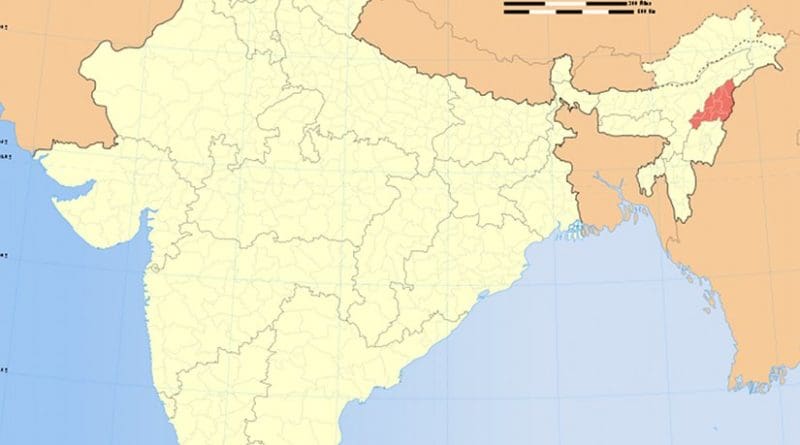Naga Peace Accord: Need To Reserve Euphoria – Analysis
By IPCS
By Wasbir Hussain*
The signing of the ‘framework agreement’ between the Government of India and the National Socialist Council of Nagaland’s Isak-Muivah faction (NSCN-IM) in New Delhi on 3 August 2015 is certainly a landmark development because it has confirmed that the two sides have succeeded in narrowing down their differences and are on the verge of reaching a Peace Accord. The government of Indian Prime Minister Narendra Modi can, of course, take credit for having been able to break the logjam with the NSCN-IM and reaching a point from where a solution to the six-decade-old Naga insurrection looks bright. After all, peace talks between the two sides have been ongoing for the past 18 years in India and abroad, ever since the NSCN-IM entered into a ceasefire with New Delhi in July 1997.
If the Modi government, led by its astute Naga peace interlocutor R. N. Ravi, could achieve this breakthrough, it was because it recognised the ‘unique history of the Nagas’, and agreed to pursue a ‘relationship of equals’. Right from the time of the legendary Naga rebel leader Angami Zapu Phizo, the Nagas have been insisting that they be left alone once the British leave India. The Nagas’ ground was that they have been an independent race and, therefore, wanted to stay outside after India attains freedom. That was not to be and the Nagas continued with their fight for an independent homeland. In this backdrop, the NSCN-IM and R. N. Ravi, who is otherwise the Chairman of the Joint Intelligence Committee, also deliberated on the Naga ‘sovereignty’ issue as also the toned down demand for integration of all Naga-inhabited areas in the Northeast into the state of Nagaland. A compromise has been reached on this and a ‘formula’ worked out which is going to be reflected in the final Accord. It is possible the Nagas living in areas outside the state of Nagaland (for instance, in Manipur, Assam and Arunachal Pradesh) could also benefit from the Naga Peace Accord although existing state boundaries are not going to be re-drawn.
That the incumbent Bharatiya Janata Party (BJP) government has chosen to emphasise on the ‘equality’ issue insofar as the relationship with the Nagas is concerned gives rise to the question as to whether ‘sovereign power’ could be shared. When the Accord is actually worked out in a couple of months’ time, one won’t be surprised if Nagaland comes to have a Jammu & Kashmir-type of a status where there could be a separate flag and so on. This may be symbolic but for the Nagas or the NSCN-IM it could mean restoration of their pride, something New Delhi is not against conceding. For instance, The Nagaland Post quoted R.N. Ravi as saying, “Nagas have suffered all these years because of lack of understanding. Their dignity and pride has to be restored. Their uniqueness will be reflected in all the competencies.”
The liberal tone with which Prime Minister Modi addressed the gathering on the occasion at his official residence demonstrated the confidence and spirit of accommodation with which he and his government has been able to tackle the issue. After the agreement was signed, Modi said “Today’s agreement is a shining example of what we can achieve when we deal with each other in a spirit of equality and respect, trust and confidence; when we seek to understand concerns and try to address aspirations; when we leave the path of dispute and take the high road of dialogue.”
Despite these positive signals, one significant aspect of the over 80 rounds of peace talks between New Delhi and the NSCN-IM, spanning 18 years, has been its secretive nature. Therefore, when the ‘framework agreement’ was signed in the presence of Prime Minister Modi, Home Minister Rajnath Singh, National Security Adviser Ajit Doval, R. N. Ravi and the top NSCN-IM leaders led by its general secretary Thuingaleng Muivah, everybody was caught by surprise, including people in Nagaland.
That means, the NSCN-IM, too, did not give any inkling to the Naga civil society that the ‘framework agreement’ was actually going to be signed on 3 August. This has led to a huge amount of scepticism among the Naga civil society and others who are eager to know if New Delhi or the NSCN-IM would ever consult them when the final accord is reached.
One would argue that the cause for euphoria at the clinching of this ‘framework agreement’ with the NSCN-IM is just not there because there are other Naga rebel factions, particularly the Khaplang-faction of the NSCN or the NSCN-K that is now outside the purview of the peace process. The NSCN-K had abrogated its 14-year-long ceasefire with New Delhi in April 2015 and has since carried out the biggest attack on the Indian army in two decades when it ambushed and killed 18 soldiers of the Dogra Regiment in Manipur’s Chandel district on 4 June 2015. The NSCN-K could now try and strike in a bid to demonstrate its presence and relevance, and that is precisely the reason why the Naga civil society is stressing on the need to once again try and get the outfit back on the road to peace.
There is a belief that the agreement with the NSCN-IM could impact on the insurgent groups in states like Assam, Meghalaya or Manipur and encourage them to shun violence and join the peace bandwagon, but that will turn into reality only if the final deal with the Isak-Muivah faction is reached fast. That, of course, may not happen as fast as one might tend to believe.
* Wasbir Hussain
Executive Director, CDPS, Guwahati, and Visiting Fellow, IPCS

